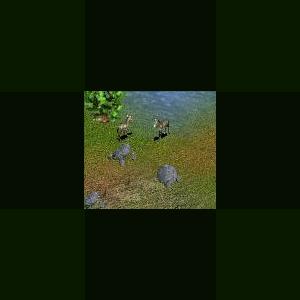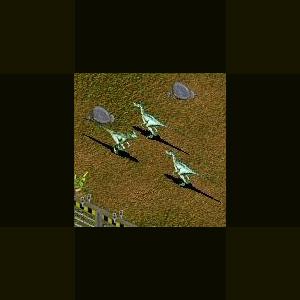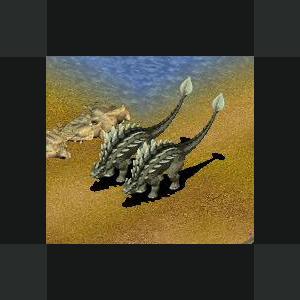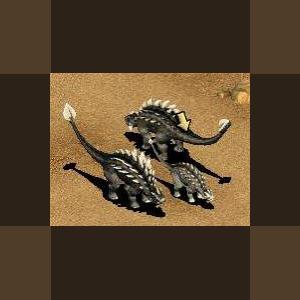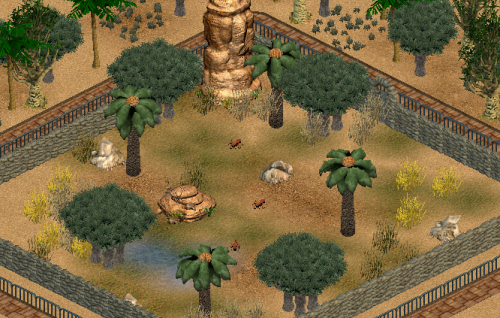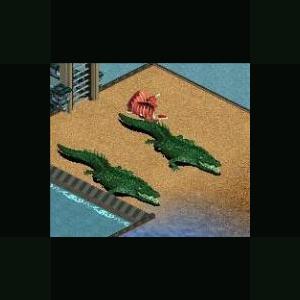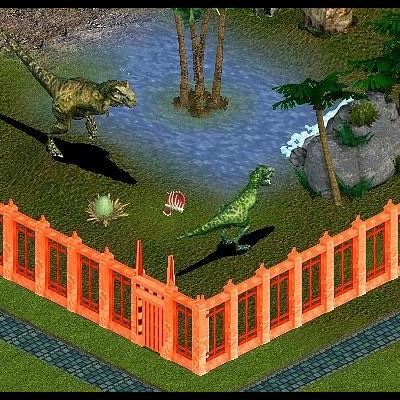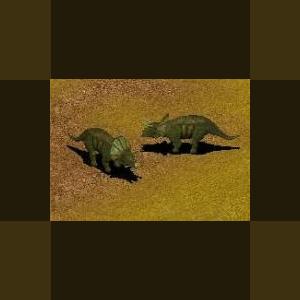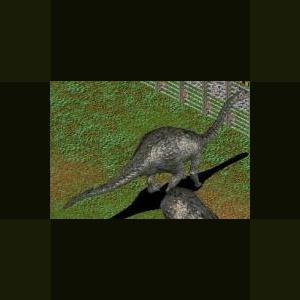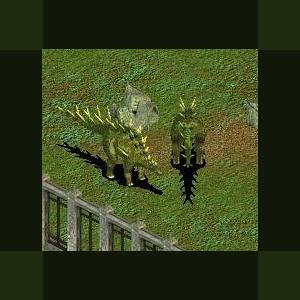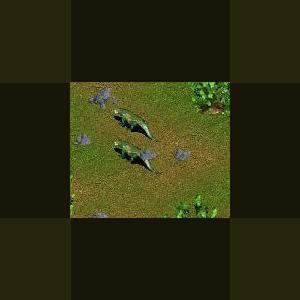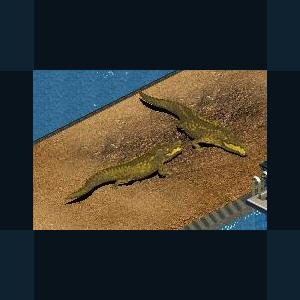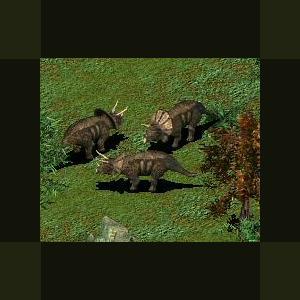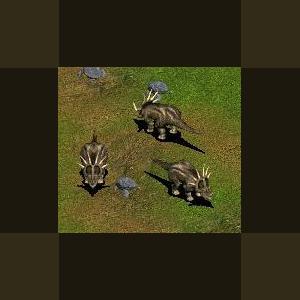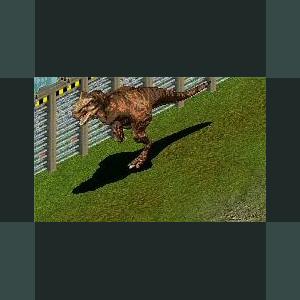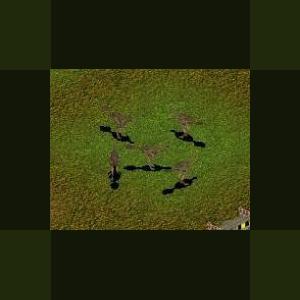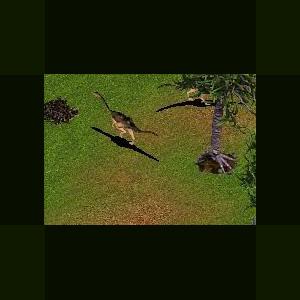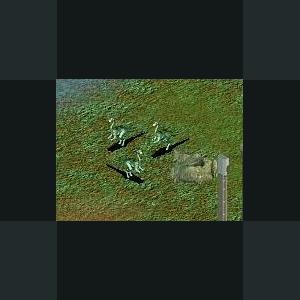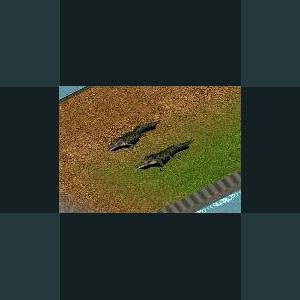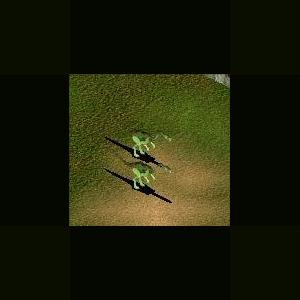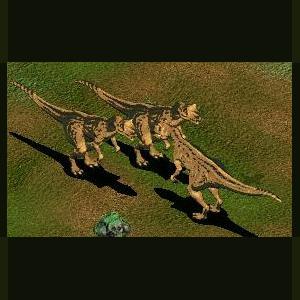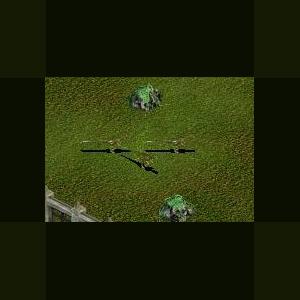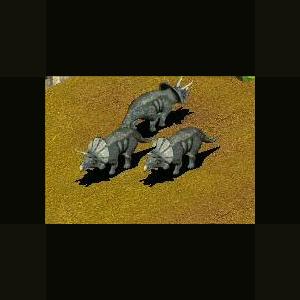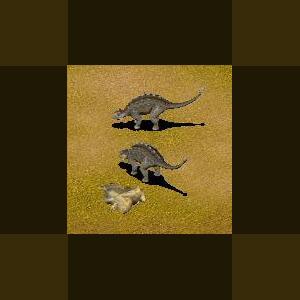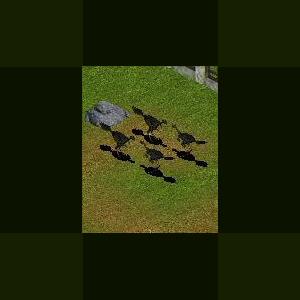Dinosaurs
Creatures from another age
241 files
-
Hipparion by Moondawg
By Guest
Hipparion (Greek, "pony") is an extinct genus of horse.
It resembled the modern horse, but still had vestigal outer toes (in addition to its hoof). These did not touch the ground. Hipparion was about 1,40 m (4 ft 8 in) tall at the shoulder.
Must have Dino Digs and/or Complete Collection in order for food to show up.
246 downloads
0 comments
Updated
-
Deinonychus by Moondawg
By Guest
This 3.4 metre (11 ft) long dinosaur lived during the early Cretaceous Period (Aptian - Albian stages, 121 to 98.9 million years ago). Fossils of the only named species (D. antirrhopus) have been recovered from the U.S. states of Montana, Wyoming and Oklahoma, though teeth that may belong to Deinonychus have been found much farther east in Maryland.
(Terrible claw) refers to the unusually large, sickle-shaped talon on the second toe of each hind foot, which was probably held up off the ground while the dinosaur walked on the third and fourth toes. It was commonly thought that Deinonychus would kick with the sickle claw to slash at its prey but recent tests on reconstructions of similar Velociraptor talons suggest that the claw was used to stab, not slash. The species name antirrhopus means (counter balance), which refers to John Ostrom's idea about the function of the tail. As in other dromaeosaurids, the tail vertebrae have a series of ossified tendons and super - elongated bone processes. These features seemed to make the tail into a stiff counterbalance, but a fossil of the very closely related Velociraptor mongoliensis has an articulated tail skeleton that is curved laterally in a long S – shape. This suggests that, in life, the tail could swish to the sides with a high degree of flexibility In both the Cloverly and Antlers Formation, Deinonychus remains have been found closely associated with those of the ornithopod Tenontosaurus. Teeth discovered associated with Tenontosaurus specimens imply it was hunted or at least scavenged upon by Deinonychus.
Paleontologist John Ostrom's study of Deinonychus in the late 1960s revolutionized the way scientists thought about dinosaurs, igniting the debate on whether or not dinosaurs were warm-blooded. Before this, the popular conception of dinosaurs had been one of plodding, reptilian giants. Ostrom noted lightweight bones and raptorial claws on the feet, which revealed an active, agile predator.
343 downloads
0 comments
Updated
-
Cedarpelta by Moondawg
By Guest
Cedarpelta is the most basal known ankylosaurid ankylosaur (Ankylosauridae; Ankylosauria), based on material recovered from the Lower Cretaceous of North America.
The skull lacks extensive cranial ornamentation, a trait which has been interpreted as plesiomorphic for ankylosaurs. Carpenter et al. (2001) diagnose Cedarpelta by the presence of a rostrocaudally elongate pterygoid with a caudolaterally oriented, trochlear-like process, a premaxilla with six conical teeth, and a straight ischium. The presence of premaxillary teeth is a plesiomorphic character because it is present in other, primitive ornithischians. In contrast, closure of the opening on the side of the skull behind the orbit, the lateral temporal fenestra, is an advanced (apomorphic) character only known in ankylosaurid ankylosaurs.
Two skulls are known, and the skull length for Cedarpelta is estimated to have been roughly 60 cm. Significantly, one of the Cedarpelta skulls was found disarticulated, a first for an ankylosaur skull, allowing paleontologists a unique opportunity to examine the individual bones instead of being limited to a cossified unit. The etymology of this binomen may be read as "Bilbey and Hall's Cedar (Mountain) shield," with the genus named for the Cedar Mountain Formation and the animal's armored plates and the species named for Sue Ann Bilbey and Evan Hall, discoverers of the type locality.
All material referrable to Cedarpelta has been recovered from the Ruby Ranch Member of the Cedar Mountain Formation. Radiometric dates place the site the specimen was collected in the (Albian) of eastern Utah.
206 downloads
0 comments
Updated
-
Gobisaurus by Moondawg
By Guest
Gobisaurus is an ankylosaur from the Upper Cretaceous Ulansuhai Formation (Nei Mongol Zizhiqu) of China.
The holotype consists of a skull and as yet undescribed postcranial remains. Along with its sister taxon Shamosaurus, Gobisaurus is "nested deep within the ankylosaurid lineage as the first successive outgroup to (the subfamily) Ankylosaurinae" (Vickaryous et. al., 2004). This is a large ankylosaur, with a skull measuring 46 cm. in length and 45 cm. across. The name means "Gobi (Desert) lizard," referring to its discovery by the Sino-Soviet Expeditions (1959–1960) in the Gobi Desert of Mongolia. The genus is monotypic, containing only G. domoculus.
237 downloads
0 comments
Updated
-
Protosolpuga by Serpyderpy
By Serpyderpy
Protosolpuga is an extinct species of solifugae known only from a single specimen that was discovered in Mazon Creek, Illinois, USA. While somewhat bigger than their real life size, these wonderful little creepy crawlies will make a nice addition to your paleozoic zoos!
83 downloads
0 comments
Updated
-
Rhamphosuchus by Moondawg
By Guest
Rhamphosuchus ("Beak crocodile") is an extinct relative of the modern gharial and false gharial.
It inhabited what is now the Indian sub-continent in the Miocene and Pliocene eras. It is only known from incomplete sets of fossils, mostly teeth and skulls, but palaeontologists estimate that it was one of the largest, if not the largest crocodylian that ever lived, reaching an estimated length of 15 to 18 m (50-60 ft). Another crocodylian, Purussaurus from the same era but living in Brazil is estimated to be of similar size from an equally incomplete fossil set. The only other crocodylians which even come close are the Late Cretaceous Deinosuchus and Early Cretaceous Sarcosuchus and also the strange planctivorous Mourasuchus which lived at the same time and in the same region with Purussaurus. As a relation to the modern gharial, Rhamphosuchus almost certainly ate fish, but whether of not it was capable of killing larger animals is unknown.
213 downloads
0 comments
Updated
-
Rainforest T-Rex by JohnT
By Admin Uploader
The T-Rex loves plenty of fresh meat, and needs the strongest fence to hold it. This Rainforest Tyrannosaurus Rex uses the same graphics as the in-game T-Rex, but with a change in habitat and object preferences, as well as different animal info. Since this T-Rex links directly to the graphics of the in-game T-Rex, you must have either DD or CC to use it. The in-game T-Rex will still be available in addition to this T-Rex.
79 downloads
- dinosaur
- rainforest
- (and 1 more)
0 comments
Updated
-
Diceratus by Moondawg
By Guest
Diceratus (meaning "two-horned") is a ceratopsid herbivorous dinosaur genus from the Late Cretaceous period of North America. It is known only from a single poorly preserved skull discovered in Wyoming and described in 1905 as Diceratops.
For many years, it had been considered a species within the genus Triceratops, but recent analysis (Forster, 1996) suggests it is a distinct genus. Since the Diceratops name was preoccupied, it was renamed to Diceratus in 2008.
Diceratus was first described as Diceratops ("two horned face"), but it was found that the name was already in use for a hymenopteran (Foerster, 1868). It was given its current name by Octávio Mateus in 2008.
The paper that described Diceratus was originally part of O. C. Marsh's magnum opus, his Ceratopsidae monograph. Unfortunately, Marsh died (1899) before the work was completed, and John Bell Hatcher endeavored to complete the Triceratops section. However, he died of typhus in 1904 at the age of 42, leaving the paper still uncompleted. It fell to Richard Swann Lull to complete the monograph in 1905, publishing Hatcher's description of a skull separately and giving it the name Diceratops hatcheri.
Since the Diceratops paper had been written by Hatcher, and Lull had only contributed the name and published the paper after Hatcher's death, Lull was not quite as convinced of the distinctiveness of Diceratops, thinking it primarily pathological. By 1933, Lull had had second thoughts about Diceratops being a distinct genus and he put it in a subgenus of Triceratops: Triceratops (Diceratops), including T. obtusus; largely attributing its differences to being that of an aged individual.
200 downloads
0 comments
Updated
-
Quaesitosaurus by Moondawg
By Guest
Quaesitosaurus ('extraordinary lizard') is a Cretaceous titanosaurian sauropod (the last of this order) found by Kurzanov and Bannikov in 1983.
The type species is Quaesitosaurus orientalis. Quaesitosaurus grew to 23 meters long. It lived from 80 to 65 million years ago.
Quaesitosaurus (meaning "extraordinary lizard") is a genus of titanosaurian sauropod found by Kurzanov and Bannikov in 1983. The type species is Quaesitosaurus orientalis. Quaesitosaurus grew to 23 meters long. It lived from 85 to 70 million years ago during the Late Cretaceous (Santonian to Campanian ages). Its fossils, consisting solely of a partial skull, were found in the Barun Goyot Formation near Shar Tsav, Mongolia. Long, low and horse-like with frontally located peg-teeth, it is similar enough to the skulls of Diplodocus and its kin to have prompted informed speculation that the missing body was formed like those of diplodocids.
It is possible that Nemegtosaurus, also known from only skull material, is a very close relative of Quaesitosaurus, if not indeed a variation of the same animal.
135 downloads
0 comments
Updated
-
Chialingosaurus by Moondawg
By Guest
Chialingosaurus (meaning "Chialing Lizard") was a type of stegosaur similar to Kentrosaurus from the Upper Shaximiao Formation, Late Jurassic beds in Sichuan Province in China.
Its age makes it one of the oldest species of stegosaurs, living about 160 million years ago. Since it was an herbivore, scientists think that Chialingosaurus probably ate ferns and cycads, which were plentiful during the period when Chialingosaurus was alive. Its name is taken from the Chialing River in southern China. Perhaps growing up to 13 ft (4m) long and weighing just 330 pounds (150 Kg), much less than other later stegosaurs.
Collected by the geologist Kuan in 1957 in Quxian County, the dinosaur was named by paleontologist C. C. Young two years later, although only very incomplete fossilized remains of Chialingosaurus have been found, and those fossil remains belong to a juvenile. In 1969, Rodney Steel suggested that Chialingosaurus might have actually been an early ancestor of other stegosaurs, but it is difficult to tell: the type specimen, Chialingosaurus kuani is known from only one partial skeleton, the original material having been supplemented in 1978 by Zhou of the Municipal Museum of Chongqing.
235 downloads
0 comments
Updated
-
Postosuchus by Moondawg
By Guest
Postosuchus was a basal archosaur which lived in what is now North America during the middle through to the late Triassic period (228-202 million years ago).
It was a rauisuchian, a cousin of crocodiles and came from the same ancestry as dinosaurs. Its name means "crocodile from Post", named after the Post Quarry in Texas, where many fossils of the species were found. It was one of the top predators of its area during the Triassic, larger than the small dinosaur predators of its time (such as Megapnosaurus and Coelophysis). It was a hunter which probably preyed on dicynodonts and many other creatures smaller than itself.
Postosuchus was a quadrupedal reptile with a wide skull and a long tail. It was about 6 meters long, 2 meters tall, and was held up by columnar legs (a quite uncommon feature in reptiles). A crocodile-like snout, filled with many large-sized dagger-like teeth, was used to kill its prey. Rows of protective plates covering its back formed a defensive shield.
288 downloads
0 comments
Updated
-
Dyrosaurus by Moondawg
By Guest
Dyrosaurus was an extinct genus of dyrosaurid crocodyliform from the Eocene of North Africa. The type species D. phosphaticus possessed slender jaws with numerous recurved teeth, indicative of a primarily fish diet (similar to the extant gharial).
The dyrosaurids represent a family of crocodiles existing from the late Cretaceous to the early Tertiary,which were outwardly similar to the modern gavials with their long,narrow,toothy snouts. They were strong swimmers and hunted fish in the shallow coastal waters or brackish river mouths.
The long narrow jaws of Dyrosaurus are full of sharp teeth and form an ideal fish trap.
The tail is a broad swimming organ and the limbs are quite long,indicating that it
spent as much time on land as it did in the water.The typical crocodile armor is
present but it is reduced compared with others of the crocodile group.The long skull
is quite lightweight with large gaps between the bones.
241 downloads
0 comments
Updated
-
Turanoceratops by Moondawg
By Guest
Turanoceratops
Turanoceratops ("Turan horn face") is a genus of ceratopsian dinosaur. Its fossil remains were recovered from the Bissekty Formation of Uzbekistan, dating to the late Cretaceous Period (mid-late Turonian stage) about 90 million years ago. It may be the only member of the family Ceratopsidae known from outside North America, and be among the earliest ceratopsids, though this interpretation has been disputed.
Turanoceratops belonged to the Ceratopsia (the name is Greek for "horned face"), a group of herbivorous dinosaurs with parrot-like beaks which thrived in North America and Asia during the Cretaceous Period, which ended roughly 65 million years ago. All ceratopsians became extinct at the end of this era.
A 2009 study lead by Hans-Dieter Sues analysed additional fossil material of Turanoceratops and concluded that, contrary to expectations, it represented a true (though "transitional") member of the family Ceratopsidae. If correct, it would represent the only Asian ceratopsid, all other species being found in North America.
Some scientists, such as Andrew Farke, disagreed with Sues' findings. Farke and colleagues ran an independent phylogenetic analysis of the new Turanoceratops fossils and found that it was a close relative of Ceratopsidae (the immediate sister group) but was not a true member of that clade. Sues and Alexander Averianov criticised that analysis, arguing that Farke and colleagues misinterpreted or mis-coded some characteristics of the fossil in their analysis.
Turanoceratops, like all ceratopsians, was a herbivore. During the Cretaceous, flowering plants were "geographically limited on the landscape", and so it is likely that this dinosaur fed on the predominant plants of the era: ferns, cycads and conifers. It would have used its sharp ceratopsian beak to bite off the leaves or needles.
196 downloads
0 comments
Updated
-
Einiosaurus by Moondawg
By Guest
Einiosaurus
Einiosaurus is a medium-sized centrosaurine (“short-frilled”) ceratopsian from the Upper Cretaceous (Campanian) Two Medicine Formation of northwestern Montana. The generic epithet means 'buffalo lizard', in a combination of Blackfeet Indian and Latinized Ancient Greek and the specific epithet means 'forward-curving horn' in Latin and Ancient Greek.
Einiosaurus was a herbivorous dinosaur and grew to 6 meters in length. It is typically portrayed with a low, strongly forward-curving nasal horn that resembles a bottle opener, though this may only occur in some adults. Supraorbital (over-the-eye) horns are low and rounded if present at all, as opposed to ceratopsids with prominent supraorbital horns such as Triceratops. A pair of large spikes projects backwards from the relatively small frill.
Low-diversity and single-species bonebeds are thought to represent herds that may have died in catastrophic events, such as during a drought or flood. This is evidence that Einiosaurus, as well as other centrosaurine ceratopsians such as Pachyrhinosaurus and Centrosaurus, were herding animals similar in behavior to modern-day bison or wildebeest. In contrast, ceratopsine (“long-frilled”) ceratopsids, such as Triceratops and Torosaurus, are typically found singly, implying that they may have been somewhat solitary in life, though fossilized footprints may provide evidence to the contrary.
Like all ceratopsids, Einiosaurus had a complex dental battery capable of processing even the toughest plants.
Einiosaurus fossils are found in the upper part of the Two Medicine Formation of Montana, dating to the mid-late Campanian stage of the late Cretaceous Period, about 75-70 million years ago. Dinosaurs that lived alongside Einiosaurus include the basal ornithopod Orodromeus, hadrosaurids (such as Hypacrosaurus, Maiasaura, and Prosaurolophus), the ankylosaurs Edmontonia and Euoplocephalus, the tyrannosaurid Daspletosaurus (which appears to have been a specialist of preying on ceratopsians), as well as the smaller theropods Bambiraptor, Chirostenotes, Troodon, and Avisaurus. It also shared its habitat with other ceratopsids: Brachyceratops and Achelosaurus. Einiosaurus lived in a climate that was seasonal, warm, and semi-arid. Other fossils found with the Einiosaurus material include freshwater bivalves and gastropods, which imply that these bones were deposited in a shallow lake environment.
Einiosaurus is an exclusively Montanan dinosaur, and all its known remains are currently held at the Museum of the Rockies in Bozeman, Montana. At least 15 individuals of varying ages are represented by three adult skulls and hundreds of other bones from two low-diversity (in species) bonebeds, which were discovered by Jack Horner in 1985 and excavated from 1985 - 1989 by Museum of the Rockies field crews. These bonebeds were originally thought to contain a new species of Styracosaurus and are referred to as such in the comprehensive taphonomic study by Ray Rogers. In 1995 Scott D. Sampson formally described and named Einiosaurus procurvicornis from this material, as well as Achelousaurus horneri, also from a bonebed in this region.
The placement of Einiosaurus within Centrosaurinae is problematic due to the transitional nature of several of its skull characters, and its closest relatives are either Centrosaurus and Styracosaurus or Achelousaurus and Pachyrhinosaurus. The latter hypothesis is supported by Horner and colleagues, where Einiosaurus is the earliest of an evolutionary series in which the nasal horns gradually change to rough bosses, as in Achelousaurus and Pachyrhinosaurus which are the second and third in this series. The frills also grow in complexity.
Regardless of which hypothesis is correct, Einiosaurus appears to occupy an intermediate position with respect to the evolution of the centrosaurines.
http://en.wikipedia.org/wiki/Einiosaurus
263 downloads
0 comments
Updated
-
Gorgosaurus by Moondawg
By Guest
Like most known tyrannosaurids, Gorgosaurus was a multi-ton bipedal predator equipped with dozens of large, sharp teeth; it also bore tiny two-fingered forelimbs typical of its close relatives. Although relatively large for a theropod, Gorgosaurus was much smaller than its more famous relative Tyrannosaurus.
Gorgosaurus (pronounced GOR-go-SAWR-us; meaning "fierce lizard") is a genus of tyrannosaurid theropod dinosaur that lived in western North America during the Late Cretaceous Period, between about 77 and 74 million years ago. Fossil remains have been found in the Canadian province of Alberta and possibly the U.S. state of Montana. Paleontologists recognize only the type species, G. libratus, although other species have been erroneously referred to the genus.
Like most known tyrannosaurids, Gorgosaurus was a bipedal predator weighing more than a metric ton as an adult; dozens of large, sharp teeth lined its jaws, while its two-fingered forelimbs were comparatively small. Gorgosaurus was most closely related to Albertosaurus, and more distantly related to the larger Tyrannosaurus. Gorgosaurus and Albertosaurus are extremely similar, distinguished mainly by subtle differences in the teeth and skull bones. Some experts consider G. libratus to be a species of Albertosaurus; this would make Gorgosaurus a junior synonym of that genus.
Gorgosaurus lived in a lush floodplain environment along the edge of an inland sea. An apex predator, it was at the top of the food chain, preying upon abundant ceratopsids and hadrosaurs. In some areas, Gorgosaurus coexisted with another tyrannosaurid, Daspletosaurus. Though these animals were roughly the same size, there is some evidence of niche differentiation between the two. Gorgosaurus is the best-represented tyrannosaurid in the fossil record, known from dozens of specimens. These plentiful remains have allowed scientists to investigate its ontogeny, life history and other aspects of its biology.
291 downloads
0 comments
Updated
-
Beipiaosaurus by Moondawg
By Guest
Beipiaosaurus is a genus of therizinosauroid theropod dinosaur.
The discovery of Beipiaosaurus , which translates as "Beipiao lizard" after a city in China near the location of its discovery, was announced in the May 27, 1999, issue of the journal Nature. These fossils were found in Liaoning Province, China and have been dated to the early Cretaceous Period, about 125 million years ago. It is known from a single species, B. inexpectus, named for "the surprising features in this animal.". A significant number of fossilized bones for this species were recovered, including: cranial fragments, a mandible, three cervical vertebrae, four dorsal vertebrae, a caudal vertebra, the scapula and scapulacoracoid, a complete forelimb, and a complete pelvis with hindlimb.
The exact classification of therizinosaurs had in the past been hotly debated, since their prosauropod-like teeth and body structure indicate that they were generally herbivorous, unlike typical theropods. Beipiaosaurus, being considered to be a primitive therizinosauroid, has features which suggest that all therizinosauroids, including the more derived Therizinosauridae, to be coelurosaurian theropods, not sauropodomorph or ornithischian relatives as once believed.
Beipiaosaurus measured 2.2 meters (7.3 ft) in length and .88 meters (2.9 ft.) tall at the hip, and is among the largest known feathered dinosaurs. Its weight is estimated as about 85 kg (187 lb.) Beipiaosaurus had a toothless beak with cheek teeth. More advanced therizinosaurids have four functional toes, but the feet of Beipiaosaurus' have reduced inner toes, showing that the derived therizinosaurid condition may have evolved from a three-toed therizinosauroid ancestor. The head was large relative to other therizinosaurs, and it had some features similar to the related oviraptorosaurs. The fossil's skin impressions indicate its body was covered by downy feather-like fibers, which are similar to those of Sinosauropteryx, but longer, and are oriented perpendicular to the arm. Xu et al. suggest that the feathers of Beipiaosaurus represent an intermediate stage between Sinosauropteryx and more advanced birds (Avialae). As only theropod dinosaurs are so far known to have been feathered, this discovery is further evidence that therizinosaurs were indeed theropods.
214 downloads
0 comments
Updated
-
Ornithomimus by Moondawg
By Guest
Ornithomimus velox was named on the basis of a foot and partial hand from the Maastrichtian Denver Formation, but better material has since been found in Canada, including the Edmontonian-age Ornithomimus edmontonicus and an excellent articulated specimen (species unknown) from Dinosaur Provincial Park. Other specimens of Ornithomimus have been discovered on the Eastern Coast of the USA
Like other ornithomimids, Ornithomimus is characterized by a three-toed foot, long slender arms and a long neck with a birdlike skull. It differs from other ornithomimids, such as Struthiomimus, in having very slender, straight hand and foot claws and in having metacarpals and fingers of similar lengths.Its hands are remarkably sloth-like in appearance, which led Henry Fairfield Osborn to suggest that they were used to hook branches during feeding.
Ornithomimus was 12 ft (3.5 meters) long, 7 feet (2.10 meters) high and weighed around 100-150 kg. It was bipedal and superficially resembled an ostrich, except for its long tail. It would have been a swift runner.
267 downloads
0 comments
Updated
-
Dryosaurus by Moondawg
By Guest
Dryosaurus
Dryosaurus (DRY-oh-sawr-us) meaning 'oak lizard', due to the vague oak shape of its cheek teeth (Greek dryo meaning 'oak' and sauros meaning 'lizard') was a genus of an ornithopod dinosaur that lived in the Late Jurassic Period. It was an iguanodont (formerly classified as a hypsilophodont). Fossils have been found in the western United States and Tanzania and were first discovered in the late 19th century. The Tanzanian site proved to be an especially fertile hunting ground for Dryosaurus fossils, this specimen was previously called Dysalotosaurus (Lost wood reptile). An expedition led by German paleontologist Werner Janensch found a great many fossils that represented Dryosaurus at all stages of development.
Dryosaurus had a long neck, long, slender legs and a long, stiff tail. Its 'arms', however, with five 'fingers' on each 'hand', were short. It was about 8 to 14 feet (2.4 to 4.3 m) long, five feet (1.5 m) tall (at the hips) and weighed 170 to 200 pounds (77 to 91 kg). Its eyes were quite large, leading many to believe that it possessed excellent eyesight.
Dryosaurus had a horny beak and cheek teeth and, like other ornithopods, was a herbivore. Some scientists suggest that it had cheek-like structures to prevent the loss of food while the animal processed it in the mouth. It was probably a herd animal, which raised and protected its young after hatching.
A quick and agile runner with strong legs, Dryosaurus used its stiff tail as a counter-balance. It probably relied on its speed as a main defense against carnivorous dinosaurs.
Its intelligence, as measured by its brain-to-body ratio, was midway when compared to other dinosaurs.
228 downloads
0 comments
Updated
-
Rutiodon by Moondawg
By Guest
Rutiodon
Rutiodon is an extinct genus of archosaurian reptile belonging to the phytosaur (plant lizard) group of the Triassic era. It was up to 3 m long.
Like other phytosaurs, Rutiodon strongly resembled a crocodile, with the only exception being the fact that its nostrils were positioned close to the eyes. Because of its enlarged front teeth, it most closely resembled the gharial. It probably caught fish and also snatched land animals from the waterside.It was an ambush predator. The animal is known from fossils in Europe (Germany and Switzerland as well as North America (Arizona, New Mexico, North Carolina, Texas). Its tail was covered with armour.
204 downloads
0 comments
Updated
-
Gojirasaurus by Moondawg
By Guest
Gojirasaurus
Gojirasaurus is a genus of dinosaur named after Gojira (the Japanese name for Godzilla). It was discovered in Revuelto Creek, Quay County, New Mexico. The type specimen is a partial skeleton of a semi-adult, about 5.5 m (18 ft) long, which can be extrapolated to a weight of approximately 150–200 kg (330–440 lb). An adult would have been around 6.5 m (21 ft) long. It lived during the Norian age of the Late Triassic Period, between 220 and 209 million years ago. Gojirasaurus was a member of the Coelophysoidea, which were all small, early theropods. Gojirasaurus was perhaps the largest meat-eater know from the Triassic Period and enormous for its time. A serrated tooth, four ribs, four backbones, and a few other bones have been uncovered.
167 downloads
0 comments
Updated
-
Megalosaurus by Moondawg
By Guest
Megalosaurus (meaning "Great Lizard", from Greek,megalo- meaning 'big', 'tall' or 'great' and sauros meaning 'lizard') is a genus of large meat-eating theropod dinosaurs of the Middle Jurassic Period (Bathonian) o
Megalosaurus was the first dinosaur to be described. Part of a bone was recovered from a limestone quarry at Cornwell near Chipping Norton, Oxfordshire, England in 1676. The fragment was sent to Robert Plot, Professor of Chemistry at the University of Oxford and first curator of the Ashmolean Museum, who published a description in his Natural History of Oxfordshire in 1677. He correctly identified the bone as the lower extremity of the femur of a large animal and he recognized that it was too large to belong to any known species; he considered it to be the thigh bone of a giant. The bone has since been lost but the illustration is detailed enough to identify it clearly as the femur of a Megalosaurus.
The Cornwell bone was described again by Richard Brookes in 1763. He named it Scrotum humanum, while describing its similar appearance to a pair of human testicles. The label was not considered to be a "name" for the animal in question at the time, and was not used in subsequent literature. Technically, the name was published after the advent of binomial nomenclature, and although this name theoretically had priority over Megalosaurus, the rules of the ICZN state that if a name falls into disuse for 50 years after publication, it is no longer in competition for priority. Therefore, the name Scrotum humanum is a nomen oblitum, or "forgotten name".
More discoveries were made, starting in 1815, again at the Stonesfield quarry. They were acquired by William Buckland, Professor of Geology at the University of Oxford and dean of Christ Church. He did not know to what animal the bones belonged but, in 1818, after the Napoleonic Wars, the French comparative anatomist Georges Cuvier visited Buckland in Oxford and realised that the bones belonged to a giant lizard-like creature. Buckland then published descriptions of the bones in Transactions of the Geological Society, in 1824 (Physician James Parkinson had described them in an article in 1822).
226 downloads
0 comments
Updated
-
Heterodontosaurus by Moondawg
By Guest
Heterodontosaurus (meaning "Different Toothed Lizard") was a small herbivorous dinosaur with sharp canine teeth which lived in the Early Jurassic of South Africa.
It was similar to a Hypsilophodont in shape, and ate plants, despite its razor-sharp canines.
Heterodontosaurus is currently known from specimens of the SAFM (South African Museum) from South Africa. There are two known morphologies of this genus, the second of which is thought by some to represent a different species. The type species, H. tucki, is from the Upper Elliot Formation of Hettangian (199-196 Million Years Ago) age. It is probably a senior objective synonym of Abrictosaurus, as has been suggested in the past.
Heterodontosaurus was a small, fleetfooted ornithischian that reached a maximum size of about 3 feet. It had a long, narrow pelvis and a pubis which resembled those possessed by more advanced ornithischians.
More unusual was that the hand of Heterodontosaurus had five fingers, two of which seem to be opposable. This configuration allowed Heterodontosaurus to grasp and manipulate food. The bone in the foot and ankle were fused in a manner reminiscent of those in birds.
Another interesting feature is the specialization of teeth which gave rise to the animal's name. Most dinosaurs (and indeed most reptiles) have a single type of tooth in their jaws, while Heterodontosaurus had three. At the front of the jaw beside the beak were small teeth likely used for chopping off leaves and stems.
Next in the jaw was a large pair of tusks whose purpose is unknown, but it is speculated that they were used as sexual displays. In that scenario, the tusks could have been used as weapons by rival males in disputes over mates and territories. The final type of teeth were tall and squared off. This type of teeth was well adapted for chewing. Fleshy cheeks helped keep the food in the mouth while chewing occurred. Chewing is relatively common in dinosaurs, but uncommon for other groups of reptiles.
This bizarre suite of teeth has led to debate over what heterodontosaurs ate. Some scientists think heterodontosaurs were omnivores who used their differently-shaped teeth to eat both plants and small animals
164 downloads
0 comments
Updated
-
Torosaurus by Moondawg
By Guest
Torosaurus (meaning "perforated lizard") was a ceratopsid dinosaur genus. It had one of the largest skulls of any land animal known, reaching 8.5 feet (2.6 meters) in length.
Torosaurus belonged to the subfamily known as Chasmosaurinae, within the family Ceratopsidae, within the Ceratopsia (which name is Ancient Greek for "horned face"), a group of herbivorous dinosaurs with parrot-like beaks which thrived in North America and Asia during the Jurassic and Cretaceous Periods. Recent studies indicate that Torosaurus is most closely related to Triceratops.[3] Jack Horner has suggested in public lectures that Torosaurus may in fact represent the adult version of one sex of Triceratops, pointing out that there are no juvenile specimens of Torosaurus and that approximately 50% of all subadult Triceratops skulls have two thin areas in the frill that correspond with the placement of "holes" in Torosaurus skulls. The theory is that all Tricertops had solid frills up to adulthood, but on reaching sexual maturity, one sex or the other would have developed longer frills as a form of display. To counterbalance the extra weight of the elongated frill, holes would have necessarily developed in the bone. While this theory does explain the absence of any Torosaurus specimens younger than adults and also explains the even split between uniformly thick frills and frills with thin patches in subadult Triceratops specimens, the theory is not widely accepted in the scientific community and has apparently not been put forward by Dr. Horner outside of informal lectures.
Inspired by the Zoo Tek Brains Trust
283 downloads
0 comments
Updated
-
Gargoyleosaurus by Moondawg
By Guest
Gargoyleosaurus parkpinorum ("gargoyle lizard") is both the smallest and the earliest known ankylosaur.
Its skull measures only 29 cm in length, and its total body length is an estimated three to four meters. It may have weighed as much as a tonne. The holotype was discovered at the Bone Cabin Quarry West locality, in Albany County, Wyoming in exposures of the Upper Jurassic (Kimmeridgian to Tithonian stages) Morrison Formation.
The next earliest known ankylosaur is Minmi paravertebrata from the Aptian stage in Queensland, Australia. The type species, G. parkpinorum (originally G. parkpini) was described by Ken Carpenter et al. in 1998. A mounted skeletal reconstruction of Gargoyleosaurus parkpinorum can be seen at the Denver Museum of Nature and Science.
The holotype specimen of Gargoyleosaurus parkpinorum was collected by Western Paleontology Labs in 1996 and is currently held in the collections of the Denver Museum of Nature and Science, Denver, Colorado. Besides the holotype, two other partial skeletons are known (although not yet described) The holotype consists of most of the skull and a partial postcranial skeleton. The specimen was originally described as Gargoyleosaurus parkpini by Carpenter, Miles and Cloward in 1998, then renamed G. parkpinorum by Carpenter et al. in 2001, in accordance with ICZN art. 31.1.2A.
Much of the skull and skeleton has been recovered, and the taxon displays cranial sculpturing, including pronounced deltoid quadratojugal and squamosal bosses. The taxon is further characterized by a narrow rostrum (in dorsal view), the presence of seven conical teeth in each premaxilla, an incomplete osseous nasal septum, a linerarly arranged nasal cavity, the absence of an osseus secondary palate, and, as regards osteoderms, two sets of co-ossified cervical plates and a number of elongate conical spines.
199 downloads
0 comments
Updated
-
Hagryphus by Moondawg
By Guest
Hagryphus
Hagryphus ("Ha's griffin", from Egyptian Ha, name of a god of the western desert and Greek gryphus meaning 'griffin' (a mythological bird-like creature); Zanno and Sampson, 2005) is an oviraptorosaurian theropod dinosaur from the Upper Cretaceous Period of what is now Utah.
To date, only a single species is known, H. giganteus. The holotype was discovered in the Kaiparowits Formation (Late Campanian) in the Grand Staircase-Escalante National Monument of southern Utah. Radiometric dating indicates that the beds where the specimen was found date to between 76 and 75 million years ago. Designated UMNH VP 12765, the type specimen resides in the collections of the Utah Museum of Natural History in Salt Lake City. It consists of an incomplete but articulated left manus and the distal portion of the left radius. Both the semilunate and radiale are preserved.
Other known species of North American oviraptorosaurs include Elmisaurus rarus, Microvenator celer, and Chirostenotes pergracilis. This group of dinosaurs is better known from the Cretaceous of Asia, where forms such as Khaan mckennai, Conchoraptor gracilis and Oviraptor philoceratops have been discovered.
Oviraptorosaurs are characterized by a shortened snout, massive endentulous jaws and extensively pneumatized skulls, often sporting elaborate crests, the function of which remains unknown. The toothless jaws may indicate a diet of eggs but these theropods likely fed on small vertebrates as well. Evidence suggests that they were feathered and some paleontologists consider them to be true birds (see the main article Oviraptorosauria for further information).
As the species name indicates, Hagryphus giganteus was a particularly large oviraptorosaur, estimated to have been approximately 3 meters (10 ft) long, which makes it one of the largest members of the clade Oviraptorosauria (Barsbold, 1976). H. giganteus is estimated to be 30-40% larger than the next largest known North American oviraptorosaur, Chirostenotes.
172 downloads
0 comments
Updated

